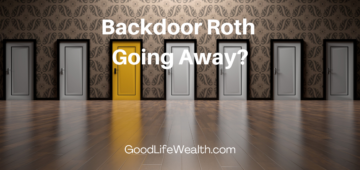If you make less than $117,150, you’ve got to look into the 12% Roth Conversion. For a married couple, the 12% Federal Income tax rate goes all the way up to $89,450 for 2023. That’s taxable income. With a standard deduction of $27,700, a couple could make up to $117,150 and remain in the 12% bracket. Above those amounts, the tax rate jumps to 22%.
For those who are in the 12% bracket, consider converting part of your Traditional IRA to a Roth IRA each year. Convert only the amount which will keep you under the 12% limits. For example, if you have joint income of $70,000, you could convert up to $47,150 this year.
This will require paying some taxes today. But paying 12% now is a great deal. Once in the Roth, your money will be growing tax-free. There will be no Required Minimum Distributions on a Roth and your heirs can even inherit the Roth tax-free. Don’t forget that today’s tax rates are going to sunset after 2025 and the old rates will return. At 12%, a $47,150 Roth conversion would cost only $5,658 in additional taxes this year. And then you will have that $47,150 growing with no future tax liabilities.
Take Advantage of the 12% Rate
If you have a large IRA or 401(k), the 12% rate is highly valuable. The key to the 12% Roth Conversion is doing it repeatedly over a period of years. If you have eight years where you can convert $40,000 a year, that’s going to move $320,000 into a tax-free account. Once you start Required Minimum Distributions, you really won’t have a choice about taking those taxable distributions. I have so many clients who don’t need their RMDs, but are forced to take out their money.
Here are some scenarios to consider where you might be in the 12% bracket:
- One spouse is laid off temporarily, on sabbatical, or taking care of young children. Use those lower income years to make a Roth Conversion. This could be at any age.
- One spouse has retired, the other is still working. If that gets you into the 12% bracket, make a conversion.
- Retiring in your 60’s? Hold off on Social Security so you can make Roth Conversions. Once you are 73, you will have both RMDs and Social Security. It is amazing how many people in their seventies are getting taxed on over $117,150 a year once they have SS and RMDs! These folks wish they had done Conversions earlier, because after 73 they are now in the 22% or 24% bracket.
Retiring Soon?
Considering retirement? Let’s say you will receive a $50,000 pension at age 65. (You are lucky to have such a pension – most workers do not!) For a married couple, that’s only $22,300 in taxable income after the standard deduction. Hold off on your Social Security and access your cash and bond holdings in a taxable account. Your Social Security benefit will grow by 8% each year. Spend the cash or bonds and defer the Social Security.
Now you can convert $67,000 a year into your Roth from age 65 to 70. That will move $335,000 from your Traditional IRA to a Roth. Yes, that will be taxable at 12%. But at age 73, you will have a lower RMD – $12,641 less in just the first year.
When you do need the money after 73, you will be able to access your Roth tax-free. And at that age, with Social Security and RMDs, it’s possible you will now be in the 22% tax bracket. I have some clients in their seventies who are “making” over $250,000 a year and are now subject to the Medicare Surtax. Don’t think taxes go away when you stop working!
Read more: Can You Reduce Required Minimum Distributions?
How to Convert
The key is to know when you are in the 12% bracket and calculate how much to convert to a Roth each year. The 12% bracket is a gift. Your taxes will never be lower than that, in my opinion. If you agree with that statement, you should be doing partial conversions each year. Whether that is $5,000 or $50,000, convert as much as you can in the 12% zone. You will need to be able to pay the taxes each year. You may want to increase your withholding at work or make quarterly estimated payments to avoid an underpayment penalty.
What if you accidentally convert too much and exceed the 12% limit? Don’t worry. It will have no impact on the taxes you pay up to the limit. If you exceed the bracket by $1,000, only that last $1,000 will be taxed at the higher 22% rate. Conversions are permanent. It used to be you could undo a conversion with a “recharacterization”, but that has been eliminated by the IRS.
While I’ve focused on folks in the 12% bracket, a Conversion can also be beneficial for those in the 22% bracket. The 22% bracket for a married couple is from $89,451 to $190,750 taxable income (2023). If you are going to be in the same bracket (or higher) in your seventies, then pre-paying the taxes today may still be a good idea. This will allow additional flexibility later by having lower RMDs. Plus, a 22% tax rate today might become 25% or higher after 2025! Better to pay 22% now on a lower amount than 25% later on an account which has grown.
A Roth Conversion is taxable in the year it occurs. In other words, you have to do it before December 31. A lot of tax professionals are not discussing Roth Conversions if they focus solely on minimizing your taxes paid in the previous year. But what if you want to minimize your taxes over the rest of your life? Consider each year you are eligible for a 12% Roth Conversion. Also, if you are working and in the 12% bracket, maybe you should be looking at the Roth 401(k) rather than the Traditional option.
Where to start? Contact me and we will go over your tax return, wage stubs, and your investment statements. From there, we can help you with your personalized Roth Conversion strategy.







